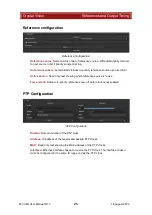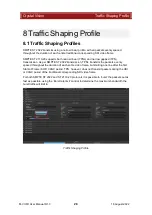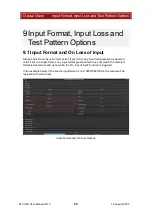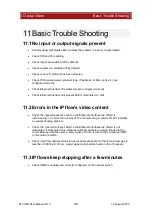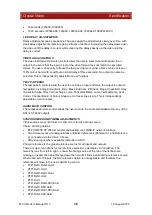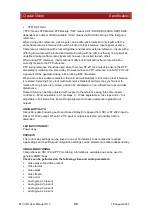
Crystal Vision
Specification
M-VIVID User Manual R1.3
36
18 August 2022
2048x1080PsF23.98*, 2048x1080PsF24*, 2048x1080PsF25*, 2048x1080PsF29.97*,
2048x1080PsF30* (*= YUV 4:2:2 10 bit)
IP PROTOCOLS
Protocols supported on network interfaces: SMPTE ST 2022-6, SMPTE ST 2022-7, SMPTE
ST 2110-20 (uncompressed video), SMPTE ST 2110-10 (system architecture and
synchronisation), SMPTE ST 2110-21 (traffic shaping), IGMPv3, ARP, ICMP ping, IPv4,
IEEE802.1q, VLAN, IEEE802.3-2012 (10G Ethernet), LLDP
Packing options of the ST 2110 output are selectable per flow between BPM and GPM (Block
Packing Mode or General Packing Mode)
Packet shaping and distribution of the video flow (compulsory in ST 2110 and optional in ST
2022) is selectable per IP output between TPNL and TPN (narrow linear or narrow gapped
packet distribution). There is also a mode for burst packet distribution with a control for the
burst rate limit. This is for connecting between Crystal Vision and other compatible devices
that allow for a reduced transmission delay
SMPTE ST 2022-7 and ST 2110 video flow protection facilitates the dual stream output
ROUTING
M-VIVID200-2 and M-VIVID400-2:
There are two clean switches that can select between the two inputs for each of the output
video delay function blocks
The default setting – which gives a dual channel video delay – is Input 1 to Output 1 and Input
2 to Output 2
It is also possible to give both video delay function blocks the same input to get multiple
outputs. The setting for this – which gives a single channel video delay with two outputs –
would be Input 1 to both Output 1 and Output 2
An alternative application is to cleanly live switch the input of a single channel video delay
without any output signal disturbance. The setting for this would be Input 1 to Output 1 cleanly
followed by Input 2 to Output 1. The second video delay function block can be used, but it is
limited to using the inputs already reserved for the first video delay function block. This might
be useful if it is required to have the same input delayed by different amounts by the two
delay functions, in which case the setting would be Input 1 to Output 1 and Output 2 cleanly
followed by Input 2 to Output 1 and Output 2
M-VIVID100-3:
There are three clean switches that can be used to select between the three inputs for the
three output video delay function blocks
The default setting – which gives a triple channel video delay – is Input 1 to Output 1, Input 2
to Output 2 and Input 3 to Output 3
It is also possible to give multiple video delay function blocks the same input to get multiple
outputs or different delay settings of the same input. To get a single channel video delay with
three outputs the setting would be Input 1 to Output 1, Output 2 and Output 3. To get a dual
channel video delay with two outputs of the first channel and one output of another, the
setting could be Input 1 to Output 1 and Output 2 and Input 3 to Output 3. An alternative
application is to cleanly live switch the input of one or more of the video delays without any
signal disturbance. However without spare inputs, clean switching can only be carried out if
one or more of the outputs is either not used or is common to one of the other outputs. For
example if the first two delays were using the same input the setting for this would be Input 1
to Output 1 and Output 2 cleanly followed by Input 2 to Output 1 and Output 2




